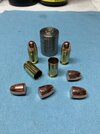Quite awhile ago was having difficulties with reloading 380 acp for a walther ppk. The problem wasn't bullet setback, but bullet pull (unusual). Had Lee make a 380 u die, and the problem was solved. It did require case belling without reexpanding the full inner dia. When i started out looking for ways to increase case neck tension or bullet setback in semi pistol calibers, went the route of not using an expanding plug or flaring in 9mm. It worked, but pinched my fingers too many times. Granted my bullet selection was not based on making that process easier and am using a single stage press. Some consider the use of an expanding plug is to help produce a consistent inside dia, which may, or may not be much more than the inside dia left after resizing differing makes of brass.
But when going the route in 9mm, could tell the difference when seating in single action press. However to determine if the desired results were being achieved, relied on testing setbck from dummy round being fed from mag using slide release. This seems to be the closest to replicate the forces the round would be subjected to. And yes, have the Redding comp pistol seaters, which really help in keeping the bullets straight while being seated.
At least in my experience, using a u die reduces the inner diam more than the resizing dies am using, which is what they are designed to do. And can tell a difference in bullet seating. Someone else's results may vary, as am not using much in the way of soft plated bullets. Am not having problems when using target full size lead in good brass.


